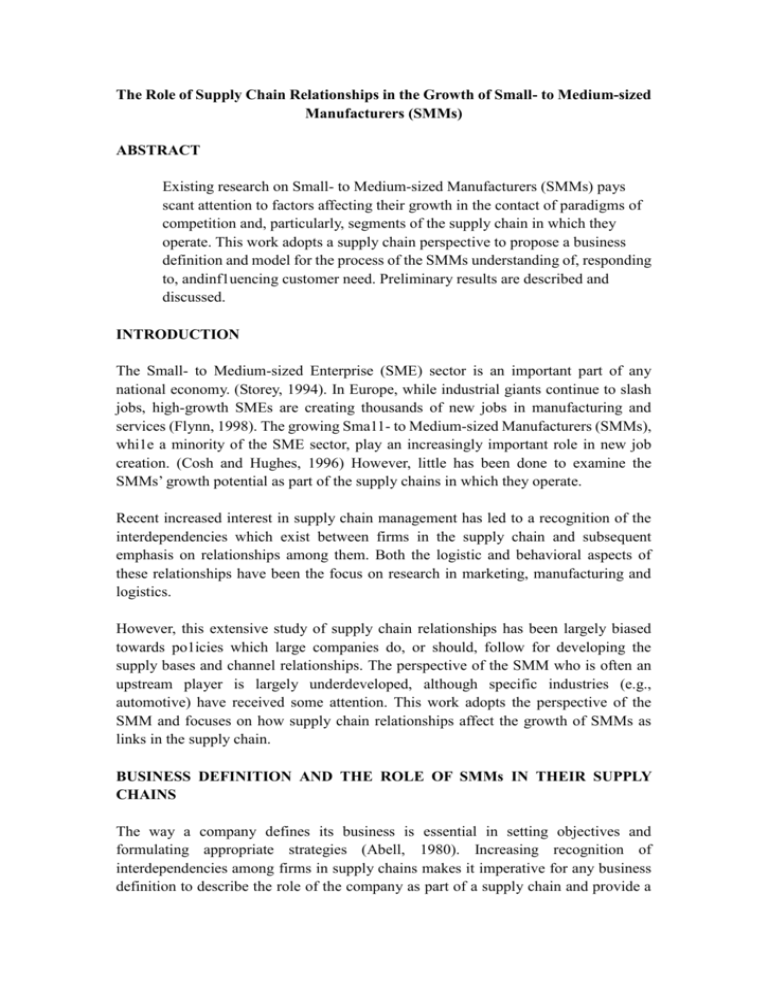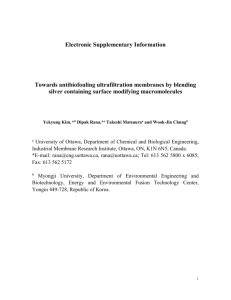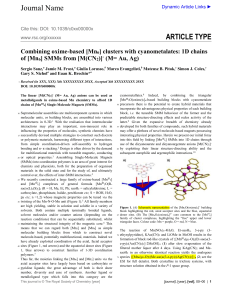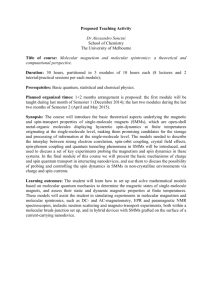Sample Paper Submission
advertisement

The Role of Supply Chain Relationships in the Growth of Small- to Medium-sized Manufacturers (SMMs) ABSTRACT Existing research on Small- to Medium-sized Manufacturers (SMMs) pays scant attention to factors affecting their growth in the contact of paradigms of competition and, particularly, segments of the supply chain in which they operate. This work adopts a supply chain perspective to propose a business definition and model for the process of the SMMs understanding of, responding to, andinf1uencing customer need. Preliminary results are described and discussed. INTRODUCTION The Small- to Medium-sized Enterprise (SME) sector is an important part of any national economy. (Storey, 1994). In Europe, while industrial giants continue to slash jobs, high-growth SMEs are creating thousands of new jobs in manufacturing and services (Flynn, 1998). The growing Sma11- to Medium-sized Manufacturers (SMMs), whi1e a minority of the SME sector, play an increasingly important role in new job creation. (Cosh and Hughes, 1996) However, little has been done to examine the SMMs’ growth potential as part of the supply chains in which they operate. Recent increased interest in supply chain management has led to a recognition of the interdependencies which exist between firms in the supply chain and subsequent emphasis on relationships among them. Both the logistic and behavioral aspects of these relationships have been the focus on research in marketing, manufacturing and logistics. However, this extensive study of supply chain relationships has been largely biased towards po1icies which large companies do, or should, follow for developing the supply bases and channel relationships. The perspective of the SMM who is often an upstream player is largely underdeveloped, although specific industries (e.g., automotive) have received some attention. This work adopts the perspective of the SMM and focuses on how supply chain relationships affect the growth of SMMs as links in the supply chain. BUSINESS DEFINITION AND THE ROLE OF SMMs IN THEIR SUPPLY CHAINS The way a company defines its business is essential in setting objectives and formulating appropriate strategies (Abell, 1980). Increasing recognition of interdependencies among firms in supply chains makes it imperative for any business definition to describe the role of the company as part of a supply chain and provide a tool to describe how this role changes over time. The business of the SMM can be seen as a function of the products/services which it offers to customers. Research in the service sector has suggested that companies which seek to grow by offering new products/services to existing customers may be more successful that those who offer current products to new customers. But all are more successful than competitors who seek to grow through the simultaneous development of products/services and new customers. The basic premise of this work is that the ability to add customers and add business with existing customers is influenced by the SMMs understanding of, responsiveness to, and influencing the needs of current and new customers. Drawing upon the manufacturing and industrial marketing literatures (for example, Abel, 1980; Forrester, 1961; Hakansson, 1982; Shapiro, 1988), a model has been developed to describe this dynamic process. This model makes explicit reference to the role of the manufacturer as a service provider. Service is reflected both in day-to-day operations, and I strategic choices of the SMM in responding to customer requirements, and influencing customer needs. These choices are assumed to surpass conventional notions of customer service, and inc1ude any program or activity which aims to redistribute allocations of roles and responsibilities along the supply chain. RESEARCH METHODOLOGY The state of current knowledge about the nature and role of supply chain relationships in the growth of SMMs calls for adoption of a mixed research methodology –the complementary tools of case studies and a general survey. This work has begun with a set of semi-structured interviews with SMMs, designed to help confirm and identify key issues for SMMs in managing supply chain relationships. From the analyses of these interviews, case studies will be developed; analyses of these data will also contribute to the design of the planned sample survey of SMMs in Engineering Industry in the UK. PRELIMINARY RESULTS The first nine semi-structured interviews with SMMs have been completed. The firms range in size from 18 to 25 employees: three have remained stable in terms of products and customers over the past three years; two have added new products or services, one has added new customers and two have added both. One SMM has added new products while "rationalizing" its customer base. This small sample does not allow the emergence of clear patterns of companies ' behavior and activities. However, some preliminary indications can be reported. Growth companies in this small sample tailor products to a customer's specific request. Their product catalogues tend to serve as a demonstration of capabilities rather than setting boundaries on product offerings. Growth companies also tend to undertake design tasks. The degree of control over design varies since some companies are subcontractors. However, even in this case, growth companies make systematic efforts to influence design by offering suggestions for improvement. The growth companies tend to make systematic efforts to increase their share of valueadded in the supply chains in which they operate. This is done in various ways, from the supply of subassemblies through development of supplementary services which were previously performed by other suppliers. It is worth noting that such developments are often of a customer-oriented rather than a customer-led origin. Some of these SMMs combine strong market awareness with heavy involvement with customer problems in order to identify market opportunities and exploit gaps left by the competition. In contrast, some firms with stable customer/product profiles have adopted a "push" philosophy, relying heavily on the technical expertise of owners. One SMM provides a remarkable example of small-firm management of a customer base. This firm has developed a world-wide network of distributors and close relationships with independent service engineers through an aggressive effort of personal selling. Shop f1oor employees train customers in product use, and the company provides training and exchanges market information with distributors. Development of such close relationships with independent service engineers who are in daily contact with customers has allowed the SMM to avoid fixed service cost while helping inf1uence buyers’ purchase decisions. Dealing effectively with big customers with complex and often uncoordinated (as perceived by the SMMs) decision-making is a problem faced by all of the SMMs interviewed. However, there are indications that provision of support services and an empowered position in the supply chain provides some of these SMMs with the opportunity to increase channels of communication as well as the degree of inf1uence they can exert on customer requirements and behavior and, ultimately, on customer needs. CONTINUATION OF THE RESEARCH While the semi-structure interviews are being complete, the survey instrument is being designed and tested: it will be administered in about nine months. At the same time, an appropriate sample of the population is being developed. Hypothesis development is being reviewed in light of preliminary findings from the interviews. Candidates for full case studies are being approached. The objective remains insight into factors affecting the growth of SMMs, with particular focus on the role of supply chain relationships in that growth. Analyses of survey data will permit some generalizations; analyses of cases will add more qualitative insight into effective practices for SMMs. REFERENCES Abell, D.F., Defining the business: The Starting Point of Strategic Planning, Prentice-Hall, New Jersey, 1980 Cosh, A. and A. Hughes, editors, The Changing State of British Enterprise: Growth, Innovation- and Competitive Advantage in Small and Medium-sized Firms 1986-95, ESRC Centre for Business Research, University of Cambridge, 1996 F1ynn, J., "Startups to the Rescue", Business Week, 23 March 23 1998, pp.50-52 Forrester J. W . , Industrial Dynamics, MIT Press, Cambridge, Massachusetts, 1961 Shapiro, B.P. "What the Hell Is 'Market Oriented’” Harvard Business Review vol.66, no.6 (1988), pp.119-125 Storey, D.J., Understanding the Small Business Sector, Routledge, 1994










